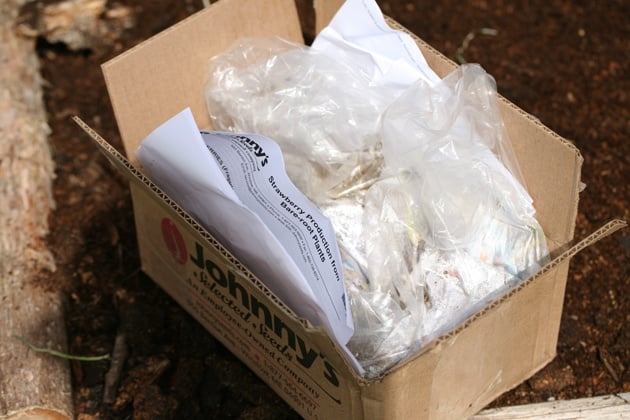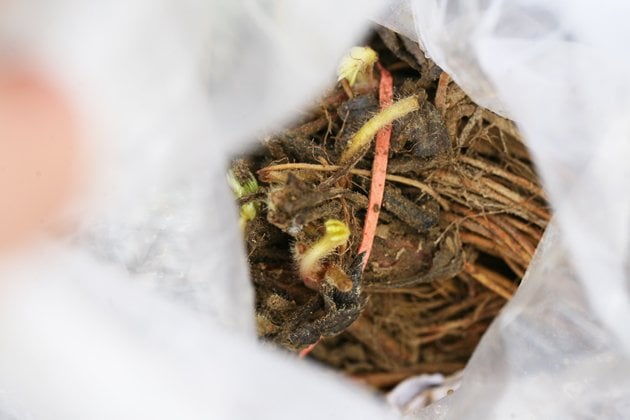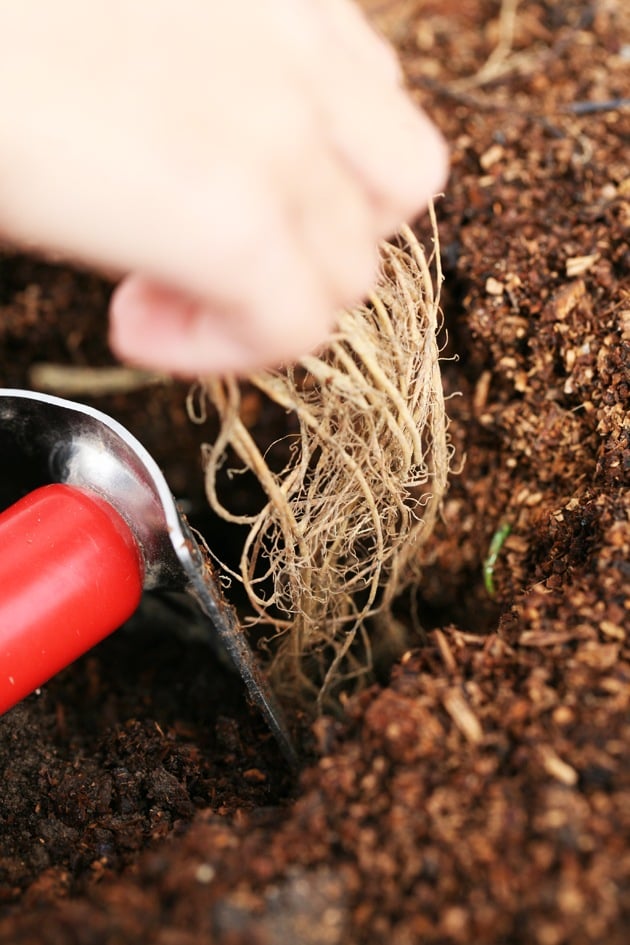How to Plant Bare Root Strawberries
This post may contain affiliate links, view our disclosure policy for details.
How to plant bare root strawberries. We’ll go over purchasing your bare root strawberries, where to plant them, when, how to plant bare root strawberries, and how to care for your plants so they produce a ton of berries!
Planting bare root strawberries might be the easiest chore in the garden. Those plants are so hardy and I doubt you could manage to kill them even if your thumbs aren’t so green!
In fact, if you’re not careful, some strawberries might take over your entire garden!
Growing fruit on the homestead can be a tricky business. Most of the fruit plants you’ll plant, whether it’s a tree or a vine or a bush, will take a few years to produce a suitable harvest and you might not live in the same place for years…
How to Plant Bare Root Strawberries…

But not strawberries! Strawberries are in between… They grow fast, you can have fruit in the first season (although you’ll benefit from not letting them produce fruit so fast (we will talk about this later).
You can plant strawberries in a container or hanging baskets (so they can go with you wherever you might end up moving) or you can plant them in the ground and dig out some of the plants or direct the runners to root in a pot that you can take with you (I’ll show you how to do this later).
And who doesn’t like fresh, garden strawberries? Think 17 times better than what you get in the store. Think sweet, deep red, juicy, melt in your mouth… Think strawberry shortcake, low sugar strawberry jam, sugar-free strawberry jam, and so on…
Table of Content…
- How strawberries grow.
- Three kinds of strawberry varieties.
- How to purchase bare root strawberries.
- Storing bare root strawberries before planting.
- When to plant bare root strawberries.
- Soil requirements for bare root strawberries.
- How to plant bare root strawberries.
- Caring for your strawberry plants.
- How to mulch strawberry plants.
- Pest issues with strawberry plants.
- How to propagate strawberry plants.
- How to harvest strawberries.
How Strawberries Grow…

Strawberries are perennial plants. Each year, they will die back in the winter and start growing again in the spring when the soil warms up. Depending on the variety of berries you choose, and with good care, you can expect a strawberry plant to produce anywhere from 3 to 5 years.
After the plant is established and bearing fruit, it will start sending runners with little, tiny plants at the tip. Those runners will root themselves nearby the mother plant but will stay attached to it.
Your plants will produce better if you make sure not to let more than three runners per mother plant root. We will talk more about this later.
Three Kinds of Strawberry Varieties…
June – Bearing Strawberries – the most popular strawberry kind. Most June-bearing varieties will bear fruit around the month of June (or a little earlier in the deep South). They will produce the largest strawberries but only during a period of two weeks to a month.
Within the June-bearing varieties, plants are classified as Early Season, Mid Season, or Late Season. This allows us to extend the harvest a little bit by choosing a few plants from each category.
Everbearing Strawberries – these plants are not really everbearing but they will produce two or sometimes three harvests during the year. The first harvest will be in late spring, then they will most likely take a break during the heat of summer, and later will produce another harvest in the fall.
The strawberries might be a bit smaller than the June -Bearing strawberries and the plants will produce fewer runners since most of its energy is geared towards producing fruit.
Everbearing strawberries are a good choice for a garden with very limited space.
Day – Neutral Strawberries – these strawberries are a modern cultivar of the everbearing strawberry, but instead of producing two or three separate harvests in a growing season, they’re supposed to give fruit continuously through summer and into the fall.
However, take into consideration that when temperatures rise above 90 degrees F they will probably take a break from producing. When temperatures cool down, they’ll start producing again.
How to Purchase Bare Root Strawberries…

It’s possible to purchase strawberry seeds, however, you will have to work rather hard to turn them into plans. The more common, and easy way is to purchase bare root strawberry plants.
In early spring, you can find strawberry plants in just about any home/garden store or at the local plant nurseries. You will have the option of buying a live, established plant, probably planted in a container or a hanging basket or you can purchase bare roots in a bag or a box.
I ordered my plants from Johnny’s Selected Seeds. When you order online, you will most likely have a larger selection of plants and also some collections you can choose from.
I chose a collection of June – Bearing strawberries (early, mid, and late) so I can extend the season just a bit but that I don’t have to pick and care for the strawberries the whole season, God knows there are a million other things that need my attention.
Storing Bare Root Strawberries Before Planting…

If you order online, you will probably get your bare roots in a box, wrapped with wet paper and in a plastic bag. If your soil is not ready for planting, make sure you keep the box in the fridge (28-32F), until you are ready.
Ideally, you’ll be able to remove the roots from the bags and plant right away…
When to Plant Bare Root Strawberries…
Early spring is the best time to plant strawberries but it’s also possible to plant them in the fall. If you live in warmer climates, even the middle of winter can work (think Arizona or Nevada…).
Strawberries are very hardy and the occasional snow or frost will not kill them.
Spring rains will help keep the bed moist and aid in getting your plants off to a good start, but if it’s dry when you’re planting, you’ll have to make sure to water your plants well.
Soil Requirements For Bare Root Strawberries…
Remember that strawberries send runners. Do you want your plants to have room to spread? If you do, make sure you plant them in a wide row or bed.
Strawberries like well-drained soil, a raised bed or a raised row will work the best. Don’t plant them in a location where water collects and stands for too long. Soil pH should be 6.5 – 6.8, just like for most vegetables.
Make sure to add a lot of compost to your soil and consider using straw mulch, the plants love it and your strawberries will be clean at harvest time.
Strawberries need around 8 hours of sun a day, so choose a location with full sun.
Lastly, don’t plant your new plants in a location that had anything from the Solanaceae family growing in it previously. This family includes tomatoes, peppers, eggplants, tobacco and such. Soil pathogens from these crops can affect strawberry plants and possibly cause soil-borne disease. Also, avoid a location that had strawberries growing in it previously.

We built a new shed around our well pump last fall and then built raised beds all around it.

I filled them with aged cow manure and topped it with aged horse manure in shavings. In the beginning, I was thinking I would plant herbs here but then decided it would be the perfect location for strawberries.
How to Plant Bare Root Strawberries…

Ok, let’s get to it! Let’s learn how to plant bare root strawberries. Get your plants out of the box and open the bag.

Pull the precious bundle out. If you order a collection, the plants will be grouped in a rubber band and marked so you know which variety is which bundle.

Carefully, remove the band and pull the plants apart. The roots will be around 8 inches long.

Next, set your plants on the soil…

So you can see where each one is going to be planted before you plant them. This way you can move things around before you plant if you want.
Make sure to space plants 12-18 inches apart. If you plant in rows, the rows have to be 3-4 feet apart.

Dig a deep hole…

And place your plant in it. Set the plant into the soil with the roots straight down. Take care not to damage the roots in the process, and make sure the middle of the crown is level with the top of the soil. Pack the soil well around the roots.
This is super important for your success:
- Deep hole, roots go straight down
- Middle of crown levels with the top of the soil
- Pack the soil around the roots

It’s important that the crown stays free of soil through the season. If you weed with a hoe, be careful not to damage it.
Caring for Your Strawberry Plants…
The first year, or the Establishment Year, is very important…
If you are growing June-Bearing strawberries:
Remove all the flower buds from the plants in the first year. This will help the plant concentrate its energy on establishing a strong root system. I know it’s so hard to do this, you want those strawberries so bad, but the result will be a much stronger plant that will bear a larger crop the following year (or the First Bearing year).
As the plant becomes established, it will start producing runners with tiny plants at the tip. During the month of July, press 2 to 3 daughter plants per main plant into the soil and remove the rest (give them to friends!). This will prevent your bed from being overcrowded.
If you grow June-Bearing strawberries you will also have to “renovate” the bed. A renovation is performed on those kinds of strawberries in order to keep the plants healthy and producing a lot of strawberries.
Renovation:
- After you harvested all your berries and the plant stops producing for the season, mow or clip the leaves to a height of 3 inches. Make sure not to damage the crown!
- Narrow your bed, each plant should have three to five inches around it. Remove weak plants.
- Add 2 inches of good compost if you grow organically or 1 – 1.5 pound of 10-10-10 fertilizer per 100 square feet if you don’t grow organically.
- Keep your plants watered until they start to regrow leaves.
If you take good care of your bed, expect your strawberry plans to produce for 3-5 years.
If you grow Everbearing or Day-Neutral strawberries:
Remove flower buds only for the first six weeks after planting, then let the plants grow and produce. It’s recommended that you remove all the runners from those plants during the first year.
Do not renovate a bed of everbearing or day-neutral strawberries, but definitely add compost (or fertilizer) every year and water well.
If you take good care of your bed, you can expect your plants to produce for two seasons.
How to Mulch Strawberry Plants…
All varieties of strawberries love mulch. you can use black plastic, heavy row covers like AG-70, or natural options like wood chips, dry leaves, or hay/straw.
Strawberries love straw! There is a theory that they are called STRAWberries because they were always grown in straw mulch, another theory is that they were packaged in straw when brought to market many years ago.
Whatever it is, they like straw. It keeps the soil moist, the weeds away, and the berries clean.
If you choose to use straw, make sure you open the bale and let it sit in the elements for a few weeks. This way all the seeds that are in there will germinate and die before you use it. You don’t want a field of wheat in your strawberry bed! (Don’t ask me how I know this…)
Also, to protect the plants in cold winters, pile the straw on top of the crowns. Then, in early spring, remove the straw from the crowns. Don’t worry if the plants are not covered and there are a couple of frosts, they are hardy and won’t die.
Pest Issues With Strawberry Plants…
Slugs, spittle-bugs, bud weevils, and tarnished plant bug are the main pests to bother your strawberries.
Moving the strawberry bed every four or five years (see below), mulching, renovation, and removing weak plants will help a lot.
You can also sprinkle diatomaceous earth around your bed, spray your plants with neem oil, or use essential oils like sandalwood, cedarwood, white fir, and peppermint.
How to Propagate Strawberries…
You have strawberries forever without buying new plants every few years! Simply use the runners to create new plants. Instead of planting the runners close to the mother plant, guide them into a container (make sure to use good container soil and to keep the soil moist). Let them root in the container while they are still attached to the mother plant.
Then, once they root and set, cut the “umbilical cord.” Now you have a new plant in a container. Make sure to establish a new bed AWAY from the old bed to minimize the chance of disease.
How to Harvest Strawberries…
If your pack of kids happened to leave a few berries on the plants, what you should do is pick them gently when they are firm and fully red. Place your harvested strawberries in a shallow container, don’t pile them more than two layers on top of each other because they will be squished and damaged.
If you happen to have a lot to harvest, make sure you don’t leave your already harvested strawberries in the sun while you harvest the rest. Find a cool place for them and then continue harvesting.
Two important tips to remember…
Heavy rains will damage your strawberries! So stay tuned to the weather forecast and go out there to harvest your berries before heavy rains.
And washed strawberries spoil fast even in the fridge, so don’t wash your strawberries after harvesting them, wait until you are ready to eat them, then wash.
OK, that’s it friends! You have all the information you need to know about how to plant bare root strawberries. Now go out there and prepare your strawberry bed and order some strawberries. We covered a lot of information, but really, the bottom line is that they are very easy plants to grow.
They are super hardy and will produce for years. If you manage your runners correctly, you will only have to purchase strawberries once, but you’ll have delicious fruit for many years!
Remember strawberry plants make a great present too. Direct one of your runners into a pot and after it roots and is growing on its own, separate it from the mother plant and gift it to a loved one and direct them to this post so they know how to care for their plant!








I planted bare root strawberries last spring and still have nothing. The mother plant is huge three ft should I cut it down.
You shouldn’t need to cut it down… Does it produce runners? It’s better to make sure you only have three of those per mother plant. What kind of strawberry is it?
Also, usually, when plants produce a lot of green foliage but no fruit/vegetables, it’s a sign that there is too much nitrogen in the soil. It might be a good idea to do a soil test.
This is a super-thorough and informative treatise on strawberry planting. I have been doing strawberries for years and years and still I picked up a thing or two. Always something new to learn. Thanks!
Thank you, Willow! I also find that, especially in farming, there is always something new to learn. Thanks for stopping by!